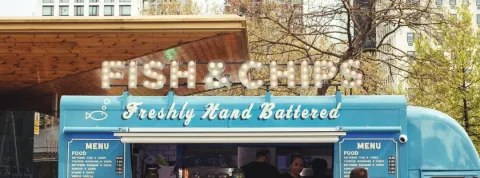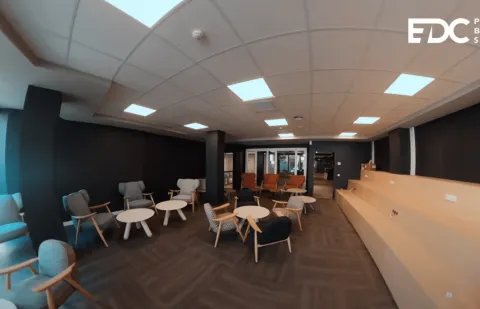
How do you create a business plan to make a food truck profitable ?
In the world of fast food, food trucks have become increasingly popular in recent years. Their ability to offer a unique culinary experience, combined with their mobility and flexibility, have made them an attractive option for entrepreneurs wanting to set up a catering business that doesn't require major investment. However, before embarking on this adventure, it's essential to create a solid business plan to validate the soundness of your project. Do you have an entrepreneurial streak? Discover our Master Management Commercial and Business Development and conquer new markets!
Why is creating a business plan for a food truck so important ?
One of the most critical aspects of setting up a food truck is assessing its financial viability. A detailed business plan will enable you to analyze the costs involved in starting up and running your food truck. You'll be able to estimate the expenses involved in buying or leasing the truck, sourcing ingredients, staff, advertising, licenses and permits, operating costs, and much more. By identifying these costs in advance, you'll be able to price your products and services in a way that ensures the profitability of your business.
A clear, well-structured business plan requires you to conduct in-depth research into the local market in which you intend to operate. You'll need to analyze consumer demand for fast food (street food and food trucks), assess the eating habits of your target audience, examine existing competition and determine how you'll stand out from the crowd. This market research will help you better understand your potential customers and adapt your offer accordingly. This will enable you to develop an attractive menu, offer unique dishes and target strategic locations to maximize your customer base.
A food truck business plan will also enable you to set realistic financial targets. By conducting a thorough cost analysis and estimating projected sales, you'll be able to determine your break-even point and develop strategies to achieve profitability. If necessary, this will help you secure financing to make the investments needed to launch your food truck, as lenders or investors will want to be reassured before making a commitment.
Steps to follow when drawing up a food truck business plan
Step 1: The management summary
The management summary (or summary executive) is a two-page summary that should give a concise but comprehensive overview of your project. It should include a description of your concept, vision, objectives, business strategy and team. It should be able to prove in a few lines that your project is a real opportunity because it meets a real need. In the case of your food truck, for example, you could emphasize the fact that many companies are present in your sector, and that the fast-food offer is notoriously inadequate.
Step 2: Market research
Thorough market research is essential to understand your target audience, assess the competition and identify growth opportunities. Analyze market trends, local eating habits, consumer preferences and street food expectations (street vendors, sandwich shops...). Also assess potential demand in the geographic area you plan to cover. Use demographic data, surveys and research to support your conclusions.
Step 3: Competitive analysis
Study the quantity and quality of other food trucks and similar restaurants in your future marketing area. Analyze exactly what they offer, their prices, location and reputation. Identify your competitors' strengths and weaknesses, and determine how you can stand out from the crowd. Highlight your competitive advantages, such as unique dishes, collaborations with local producers or additional services you offer.
Step 4: Marketing strategy
Develop a solid marketing strategy to attract and retain customers. Describe how you plan to promote your food truck, whether through social networks, advertising or partnerships with other businesses. Also draw up a communication plan to keep your customers engaged and get their feedback.
Step 5: Financial information
This is one of the most important sections of your business plan. Draw up a detailed financial plan, including start-up costs, monthly operating expenses, sales forecasts and financial targets. Analyze the investments needed to purchase or fit out your truck, as well as recurring costs such as ingredient supplies, personnel, fuel, permits and licenses. Don't forget to calculate your break-even point, and plan measures to ensure the profitability of your food truck. Your financial plan should also include a projected balance sheet and a cash flow plan analyzing monthly cash receipts and disbursements.
Step 6: The operational plan
In this section, detail the operational aspects of your food truck. Talk about your menu, suppliers, opening hours, inventory management, supply logistics, equipment and regulatory requirements. Demonstrate that you've thought through all the details needed to run your food truck efficiently and in compliance with health and safety standards.
How do you calculate food truck sales ?
The first step in calculating a food truck's turnover is to collect sales figures. You need to accurately record all sales made every day. Preferably use a computerized system to make it easier to keep track of transactions. Be sure to include all sources of revenue, including food, drink and any merchandising (such as caps, t-shirts or decorated glasses).
Once you've calculated the daily turnover, you can determine the monthly turnover. To do this, simply add up the daily sales over a thirty-day period. For example, if your average daily turnover is 500 euros, your monthly turnover would be 15,000 euros (500 euros x 30 days).
You also need to take seasonal variations into account, as your sales can fluctuate according to the seasons, local events and consumer habits. Analyze your food truck's historical data to identify the busiest and least busy months. Use this information to adjust your sales forecasts and take appropriate measures to mitigate slower periods.
To get a complete financial picture, it's essential to take into account the cost of sales, which represents the direct cost of the ingredients and materials used to prepare the dishes sold. You need to subtract the cost of goods sold from sales to obtain your gross margin, which is an objective measure of your food truck's profitability.
On which social networks and events can a food truck be promoted ?
Effective promotion of a food truck is essential to attract customers and grow your business. Social networks and events are powerful tools for increasing the visibility of your food truck and connecting with your target audience.
Social network 1: Facebook
Facebook is one of the most popular social media platforms. Create a Facebook page dedicated to your food truck and share regular updates on your locations, menu, special events and promotional offers. Use eye-catching photos to showcase your dishes, and encourage your customers to leave reviews and share their experiences.
Social network 2: Instagram
Instagram is a visual platform par excellence, ideal for showcasing the appetizing presentation of your dishes. Create an Instagram account for your food truck and share mouth-watering photos and videos of your culinary creations.
Social network 3: TikTok
TikTok is a platform focused on visual and entertaining content. You can take advantage of this dynamic to create engaging videos that showcase your cuisine, your team and the unique experience you offer with your food truck, while demonstrating your originality to stand out from the competition.
Social network 4: Linkedin
It can be a good idea to use LinkedIn to connect with other food industry professionals, build partnerships and participate in relevant discussion groups. Publish industry-related content, such as articles on street food trends or tips for food truck entrepreneurs.
Event 1: Festivals
Festivals, and especially culinary festivals, are popular events where food trucks can easily raise their profile.
Event 2: Local markets
Look for farmers' markets, craft markets or neighborhood markets in your area and reserve a space for your truck. These markets often attract an audience interested in local produce and unique dishes, which can help you stand out from the crowd and attract new customers.
Event 3: Sporting events and concerts
Many spectators are looking for fast, convenient catering options during these events. Find out about mobile catering policies at these events and offer your services. Make sure you're well prepared in terms of stock and staff to cope with an influx of customers.
Would you like to learn how to set up a business so you can get started in the best possible conditions? Follow our Master Management Commercial and Business Development and learn in-depth business skills to maximize your chances of success.
THE LATEST NEWS
Your campus at La Défense !
29 09 2021 | Our news
Watch a video of your new campus in the heart of La Défense
Rentrée décalée janvier 2022 : une nouvelle chance d’intégrer une Grande Ecole de management sans perdre votre année !
24 08 2021 | Admissions I Concours I Nos actualités
Vous êtes titulaire du baccalauréat et toujours en recherche de formation en grande école ? Vous avez choisi une orientation pour vos études supérieures qui ne vous correspond pas ? Dès le 25 janvier 2022, EDC Paris Business School vous offre la possibilité de ne pas perdre votre année grâce à sa rentrée décalée en cursus accéléré pour le Programme Grande Ecole et le Bachelor.


